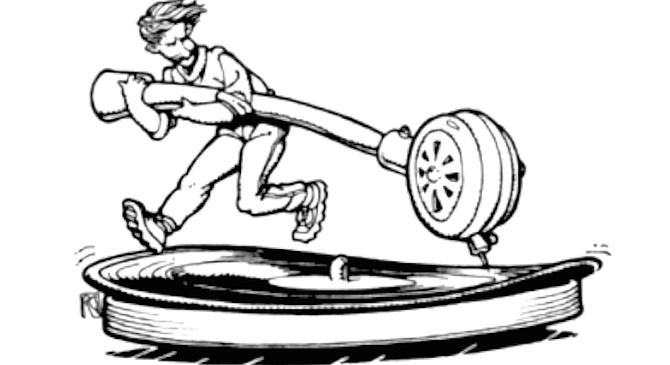 Facebook
Facebook
 X
X
 Instagram
Instagram
 TikTok
TikTok
 Youtube
Youtube

Dear Matthew Alice: As playback of sound recordings progressed from the scratchy, quick-playing 78s to the (what used to be modem) LP, why was 33-1/3 rpm chosen as the industry standard, rather than 32 or 34 or 35? And what ever happened to 16 rpm? Did it just never really catch on? — Russell Fleming, San Diego
How refreshingly irrelevant. A whole technology come and gone and we're just now getting around to asking, “Uh, by the way, uh, why’d they do that, eh?”
Edison’s cylindrical recordings — wax tubes that looked a little like you were listening to tunes on the cores from toilet paper rolls — and the earliest flat disks (invented in the late 1880s) were played on hand-cranked machines and intended to spin at around 80 rpm. A nation of weary music buffs was grateful in 1925 when someone got the idea of adding a 3600 rpm electric motor into the mix, using 46:1 reduction gearing between the motor and the turntable. These were commonly available bits of machinery at the time and kept the disks spinning at about 78 rpm. But until electrical recording methods and the magnetic stylus were invented, fidelity was hit and miss, at best.
Advancing technology meant that better sound quality could be maintained at slower speeds, which allowed more music to be crammed onto a platter. It just happened that the optimum balance of playing time and fidelity for the technology of the day came at 33-1/3 rpm. Unfortunately, the industry came up with the LP right about the time we were all busy with the Depression and weren’t ready to chuck our old phonographs for the newer models. In 1948 Columbia Records finally made the all-out push for the 33-1/3 LP to be the popular standard, just as we were pocketing all those bucks from our post-war economy. LPs were especially popular for classical recordings; a whole symphonic movement could now be put on a single side. Columbia’s big competitor, RCA, headed off on its own and began producing records meant to be played at 45 rpm. The choice was completely arbitrary; RCA just wanted a speed that was different from Columbia’s, though they tried to dupe us into thinking 45 rpm produced the best fidelity. In reality, a 45 was just a more compact version of a 78, since both held the same amount of music. And the big center hole in the 45s meant people had to buy one of RCA’s special players to accommodate the disks. The war of the 33s and 45s went on into the ’50s, when finally Columbia began producing 45s and RCA gave in and launched 33s. The 16-2/3 rpm disks were so lo-fi that they were only suitable for spoken-word recordings and never much caught on. But now that the average home has turned its phono turntable into a Lazy Susan spice rack for the kitchen cabinet, all this is ancient history.


Dear Matthew Alice: As playback of sound recordings progressed from the scratchy, quick-playing 78s to the (what used to be modem) LP, why was 33-1/3 rpm chosen as the industry standard, rather than 32 or 34 or 35? And what ever happened to 16 rpm? Did it just never really catch on? — Russell Fleming, San Diego
How refreshingly irrelevant. A whole technology come and gone and we're just now getting around to asking, “Uh, by the way, uh, why’d they do that, eh?”
Edison’s cylindrical recordings — wax tubes that looked a little like you were listening to tunes on the cores from toilet paper rolls — and the earliest flat disks (invented in the late 1880s) were played on hand-cranked machines and intended to spin at around 80 rpm. A nation of weary music buffs was grateful in 1925 when someone got the idea of adding a 3600 rpm electric motor into the mix, using 46:1 reduction gearing between the motor and the turntable. These were commonly available bits of machinery at the time and kept the disks spinning at about 78 rpm. But until electrical recording methods and the magnetic stylus were invented, fidelity was hit and miss, at best.
Advancing technology meant that better sound quality could be maintained at slower speeds, which allowed more music to be crammed onto a platter. It just happened that the optimum balance of playing time and fidelity for the technology of the day came at 33-1/3 rpm. Unfortunately, the industry came up with the LP right about the time we were all busy with the Depression and weren’t ready to chuck our old phonographs for the newer models. In 1948 Columbia Records finally made the all-out push for the 33-1/3 LP to be the popular standard, just as we were pocketing all those bucks from our post-war economy. LPs were especially popular for classical recordings; a whole symphonic movement could now be put on a single side. Columbia’s big competitor, RCA, headed off on its own and began producing records meant to be played at 45 rpm. The choice was completely arbitrary; RCA just wanted a speed that was different from Columbia’s, though they tried to dupe us into thinking 45 rpm produced the best fidelity. In reality, a 45 was just a more compact version of a 78, since both held the same amount of music. And the big center hole in the 45s meant people had to buy one of RCA’s special players to accommodate the disks. The war of the 33s and 45s went on into the ’50s, when finally Columbia began producing 45s and RCA gave in and launched 33s. The 16-2/3 rpm disks were so lo-fi that they were only suitable for spoken-word recordings and never much caught on. But now that the average home has turned its phono turntable into a Lazy Susan spice rack for the kitchen cabinet, all this is ancient history.
Comments